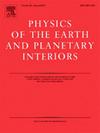高压下硫酸镁水溶液的粘度测量:对大型冰冻卫星地下流体的影响
IF 1.9
3区 地球科学
Q2 GEOCHEMISTRY & GEOPHYSICS
引用次数: 0
摘要
木卫二、木卫三、木卫四和土卫六等大型冰冻卫星厚厚的冰壳下的地下海洋和盐水是探索潜在宜居性的最有希望的目标之一。这些液体的物理性质,特别是粘度,在控制流体动力学以及高压环境中发生的物质和热传输中起着重要作用。虽然硫酸镁(MgSO4)可能是这些地外海洋中的主要溶解盐之一,但其在高压条件下的粘度仍然知之甚少。在这项研究中,开发了一种带有金刚石砧细胞(DAC)的落球粘度计,用于测量压力高达1100 MPa,温度范围为263至313 K的10 wt% MgSO4溶液的粘度。我们的研究结果表明,在相同压力和温度条件下,MgSO4溶液的粘度是纯水的1.5倍以上。在低温下,MgSO4溶液的粘度随压力单调增加,而纯水在~ 200 MPa时粘度最小。这种差异反映了Mg2+和SO42−离子对水结构破坏和水化壳构建的强离子效应。通过将我们的发现外推到地下海洋条件,我们估计在压力低于700 mPa时,冰冻卫星中10%的含水MgSO4海洋/盐水的粘度在1至13 mPa·s之间。这一发现表明,与纯水相比,冰卫星中可能存在的含水MgSO4流体具有更高的粘度,纯水的粘度通常限制在1-2 mPa·s的狭窄范围内。本文章由计算机程序翻译,如有差异,请以英文原文为准。

Viscosity measurements of aqueous magnesium sulfate solutions under high pressure: Implications for subsurface fluids in large icy satellites
Subsurface oceans and brines beneath the thick icy crust of large icy satellites such as Europa, Ganymede, Callisto, and Titan are among the most promising targets for exploring potential habitability. The physical properties of these liquids, particularly viscosity, play a fundamental role in governing fluid dynamics, as well as material and heat transport occurring within high-pressure environments. Although magnesium sulfate (MgSO4) is likely one of the primary dissolved salts in these extra-terrestrial oceans, its viscosity under high-pressure conditions remains poorly understood. In this study, a falling-sphere viscometer was developed with a diamond anvil cell (DAC) to measure the viscosity of 10 wt% MgSO4 solutions at pressures up to 1100 MPa and temperatures ranging from 263 to 313 K. Our results showed that MgSO4 solutions exhibited viscosities more than 1.5 times as high as that of pure water at the same pressure and temperature conditions. At low temperature, the viscosity of MgSO4 solutions increased monotonically with pressure, whereas pure water exhibited a minimum viscosity at ∼200 MPa. This difference reflects the strong ionic effects on the disruption of water structure and construction of hydration shell by Mg2+ and SO42− ions. By extrapolating our findings to subsurface ocean conditions, we estimated that 10 wt% aqueous MgSO4 oceans/brines in icy satellites would have viscosities between 1 and 13 mPa·s at pressures below 700 MPa. This finding suggests that aqueous MgSO4 fluids potentially present in icy satellites can exhibit higher viscosities compared with pure water, whose viscosities are typically limited to the narrow range of 1–2 mPa·s.
求助全文
通过发布文献求助,成功后即可免费获取论文全文。
去求助
来源期刊

Physics of the Earth and Planetary Interiors
地学天文-地球化学与地球物理
CiteScore
5.00
自引率
4.30%
发文量
78
审稿时长
18.5 weeks
期刊介绍:
Launched in 1968 to fill the need for an international journal in the field of planetary physics, geodesy and geophysics, Physics of the Earth and Planetary Interiors has now grown to become important reading matter for all geophysicists. It is the only journal to be entirely devoted to the physical and chemical processes of planetary interiors.
Original research papers, review articles, short communications and book reviews are all published on a regular basis; and from time to time special issues of the journal are devoted to the publication of the proceedings of symposia and congresses which the editors feel will be of particular interest to the reader.
 求助内容:
求助内容: 应助结果提醒方式:
应助结果提醒方式:


